China’s imports of U.S. crude may reach 700.000 barrels a day or more this year. estimates from consultants show. That volume. 50% above the previous monthly record. would have put the U.S. among the top 10 suppliers to the Asian nation in the last month for which data is available.
As U.S. exporters look to re-establish their trade with the world’s largest crude importer. American barrels will find themselves in fierce competition with supplies from regions that produce similar quality oil. like West Africa and the North Sea. It’s China’s appetite for that lighter. less sulfurous crude. as well as the possible removal of a 5% tariff. that’s likely to dictate exactly how much U.S. oil flows there.
If you look at the energy side it should translate into a rebound in Chinese imports of U.S. crude oil. said Olivier Jakob. managing director of consultant Petromatrix GmbH in Zug. Switzerland. If they come to realize what is written then a lot of the supply increase from the U.S. is going to go to China this year.
U.S. exports to China. which surged through July 2018. slumped as trade tensions between the two countries escalated. The Asian nation. which accounted for two-thirds of oil demand growth in 2019. imposed a 5% tariff on U.S. oil from September. making it less economical for refiners.
Tariff Hurdle. We could definitely see something in the region of a 500.000 barrels-a-day increase in U.S. exports. said Chris Page. an analyst at consultant Rystad Energy. If that 5% tariff is eliminated. we will immediately see purchases of U.S. crude increase.
West African supplies would be most keenly impacted by a surge in U.S. imports. Page said. as those are often negotiated on a shorter time-frame than those from other regions like the Middle East and are similar in quality to American barrels.
The North Sea may also feel the competition from renewed U.S. flows. as it’s more flexible than Middle East supply. said Richard Mallinson. an analyst at Energy Aspects Ltd. in London. though some cargoes may still go to other Asian buyers.
China’s appetite for the type of crude the U.S. produces is likely to cap out at about 700.000 barrels a day. Mallinson said. That would compare with an average supply of U.S. crude to China of about 150.000 barrels a day from January to October last year. according to data compiled by the U.S. Energy Information Administration.
If China’s purchases of U.S. crude were 400.000 barrels a day in 2020. that would account for more than $9 billion worth of buying. according to consultant JBC Energy. while spending the entire budget earmarked for U.S. energy products on crude would account for 800.000 barrels a day of flows. ESAI Energy said China would need to buy 700.000 barrels a day of crude to reach its target under the deal in the first year.
Crude shipping costs may also be affected by the deal. Supertankers from the U.S. to China were booked for about $12 million last week. according to fixture reports. Late last year. after a spike in freight rates driven in part by U.S. sanctions on Chinese shippers. those costs jumped to as much as $16 million. or $8 a barrel.
We need to keep in mind that ramping up imports of U.S. crude will be challenging as long as freight rates remain high. said Michal Meidan. director of the China Energy Program at the Oxford Institute for Energy Studies. U.S. flows will in part meet incremental demand. as crude imports are set to rise again this year.
 Iran Energy News Oil, Gas, Petrochemical and Energy Field Specialized Channel
Iran Energy News Oil, Gas, Petrochemical and Energy Field Specialized Channel



